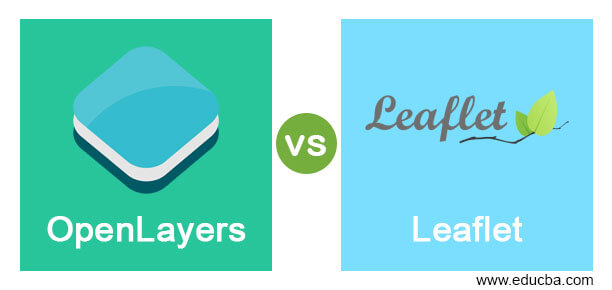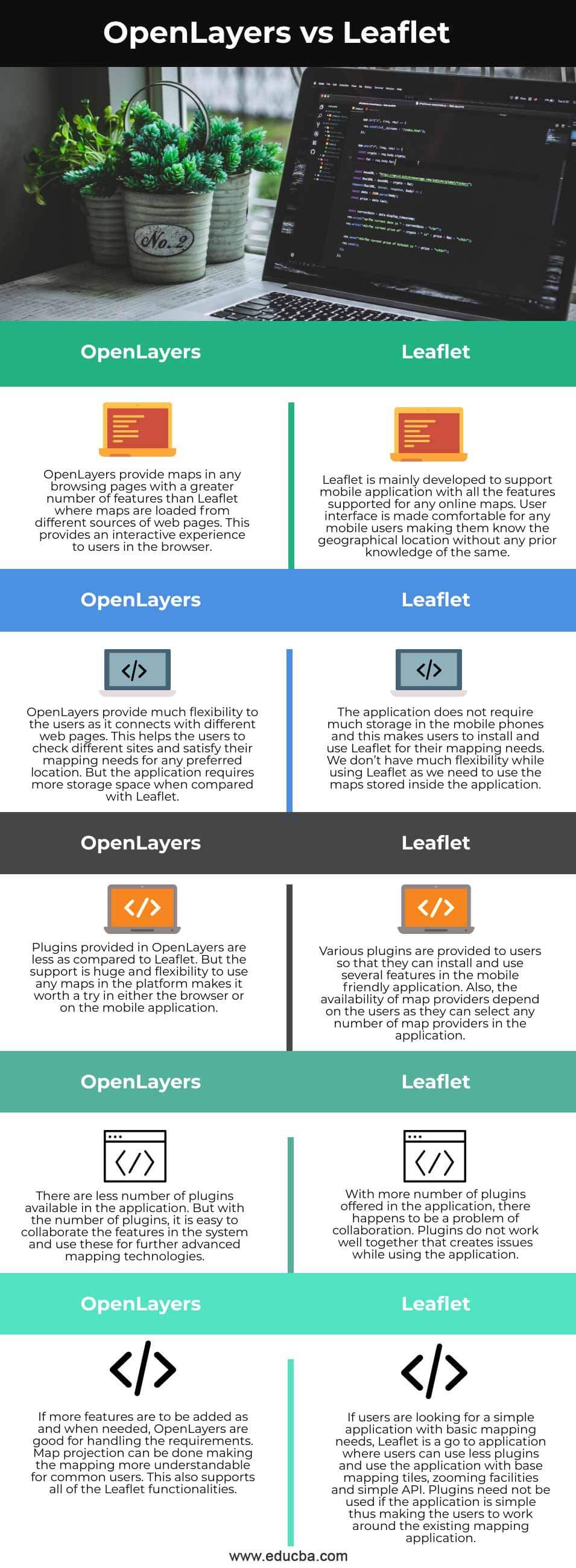Updated April 5, 2023
Difference between OpenLayers vs Leaflet
A JavaScript library that helps in displaying map data in any of the web browsers as slippy maps with an API Application provided for free is called OpenLayers. The API is enriched with multiple geographic applications that help the users to build the application like Google maps. Leaflet is also a JavaScript library that helps in creating mapping applications and is provided for free. Tiled maps can be created by developers in the browsers without any geographical information of the place for which the map is created. Interactive layers can be created so that users can make use of popups and markers from the application.
Head to Head Comparison between OpenLayers vs Leaflet (Infographics)
Below are the top 5 differences between OpenLayers vs Leaflet:
Key Differences between OpenLayers vs Leaflet
Following are the Key differences between OpenLayers vs Leaflet are given below:
- Both OpenLayers and Leaflet offer common features like tiled layers, vector layers, and mobile support of the application. Tiled layers in OpenLayers can pull the information from any web page as per the requirement of the user. Also, if needed, untiled layers can also be used. Geospatial mapping services can also be used based on needs. The leaflet provides a zooming option so that users can find the exact location in the tiled layers while scrolling through the maps. We can install both the applications on mobiles but Leaflet is more lightweight. OpenLayers are building components that are lightweight and mobile-friendly so that users can use the same.
- Community support is huge for both the applications and since they are open source, the codes are saved in the git repository where developers can make changes in the codes and use them for further development of features. OpenLayers can be considered a full-fledged application with fewer dependencies as it can work alone as a GPS system as and when needed. This independence cannot be expected from Leaflet as the plugins do not support each other and will create dependencies any time of the day.
- If we want more customized mapping support, more JavaScript coding is required that helps to manage the application with any functional requirements. Hence low-level API is used in the application. This API helps to control the application as it is not needed to do it manually. Meanwhile, high-level API is used in Leaflet making users write less code for the same. If we are not using plugins, we should write more scripts or it can be managed with the plugins and the application will be made complex.
- Features are common in both applications but they are achieved in a different manner. If a user needs an application just to look for the location, Leaflet is best. And if he needs more information about the same, he can install plugins and use them for any number of features in the same application. But if the user needs to build something from the scratch and needs to use it throughout the lifetime, OpenLayers is best as users can customize the application and write codes whenever needed. The leaflet is the choice for simple applications and OpenLayers is the choice for complex applications.
- We can connect with external servers while using OpenLayers and fetch information from the same or import excel sheets from the servers and use it in the application. We can import excel sheets in Leaflet as well but it is not easy to connect with servers while using the application. We should install plugins for the same.
It always depends on the users when to use Leaflet and OpenLayers. If the usage is simple like installing and using it in mobile phones, Leaflet is best but if users require a more complex application and if they are okay with more scripts, OpenLayers is the best choice.
OpenLayers vs Leaflet Comparison Table
Comparison between OpenLayers vs Leaflet is given below:
|
OpenLayers |
Leaflet |
| OpenLayers provides maps in any browsing pages with a greater number of features than Leaflet where maps are loaded from different sources of web pages. This provides an interactive experience to users in the browser. | Leaflet is mainly developed to support mobile applications with all the features supported for any online maps. User interface is made comfortable for any mobile users making them know the geographical location without any prior knowledge of the same. |
| OpenLayers provides much flexibility to the users as it connects with different web pages. This helps the users to check different sites and satisfy their mapping needs for any preferred location. But the application requires more storage space when compared with Leaflet.
|
The application does not require much storage in mobile phones and this makes users install and use Leaflet for their mapping needs. We don’t have much flexibility while using Leaflet as we need to use the maps stored inside the application. |
| Plugins provided in OpenLayers are less as compared to Leaflet. But the support is huge and the flexibility to use any maps in the platform makes it worth a try in either the browser or on the mobile application. | Various plugins are provided to users so that they can install and use several features in the mobile-friendly application. Also, the availability of map providers depends on the users as they can select any number of map providers in the application. |
| There are less fewer plugins available in the application. But with the number of plugins, it is easy to collaborate the features in the system and use these for further advanced mapping technologies. | With more plugins offered in the application, there happens to be a problem of collaboration. Plugins do not work well together that creates issues while using the application. |
| If more features are to be added as and when needed, OpenLayers is good for handling the requirements. Map projection can be done making the mapping more understandable for common users. This also supports all of the Leaflet functionalities. | If users are looking for a simple application with basic mapping needs, Leaflet is a go-to application where users can use fewer plugins and use the application with base mapping tiles, zooming facilities, and simple API. Plugins need not be used if the application is simple thus making the users work around the existing mapping application. |
Recommended Articles
This is a guide to OpenLayers vs Leaflet. Here we also discuss the OpenLayers vs Leaflet key differences with infographics and a comparison table. You may also have a look at the following articles to learn more –




